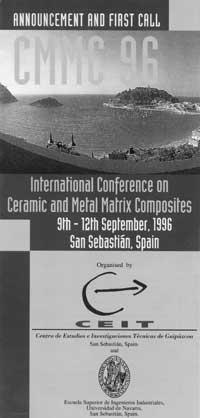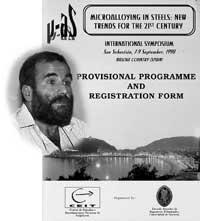CMMC'96: Congress on composites in Donostia
1996/09/01 Rodriguez Ibabe, Jose Maria Iturria: Elhuyar aldizkaria
For twenty years, material science has undergone major changes. Undoubtedly, its advancement is based on different factors. On the one hand, improvements and expansions of laboratory equipment have significantly contributed to reinforcing the fundamentals of material science. On the other hand, research teams are interdisciplinary, that is, the joint work of physicists, chemists and engineers has become commonplace, which has allowed a lot of in-depth knowledge of materials from a different perspective. As a result, new materials are being invented and others move from the laboratory scale to the industrial process.

Therefore, the designer now has a wide range of materials for many applications. Consequently, the election has become much more complicated. In many cases there is strong competition between conventional metals and new alloys. In addition, the special features of the totally 'new' materials cannot be discarded and their selection gives new possibilities to the designer. These new materials include composites.
Composite is a material that meets the following requirements:
- They consist of two or more physically separable and mechanically separable components.
- Materials can be obtained by mixing different components, controlling the amount from one to the other, modifying their properties and improving.
- The properties of the composite are more suitable than those of each of the components, and often those that only have it.
The geometries used to form composites can be different. In some cases, fibers, discontinuous or discontinuous are included within a matrix. Others, particles, etc. According to the matrix, in general, three large groups can be distinguished: polymeric composites, metallic and ceramic.
From the application point of view, polymeric composites have been the most successful. In the case of inorganic composites, industrial applications are slowly spreading. On the one hand, and to make known the latest technological advances, the CEIT Technology Center has organized in Donostia from 9 to 12 September the international congress CMMC'96 (Ceramic and Metal Matriz Composites). The following topics will be discussed at the congress:
- Processing and manufacturing of composites
- Fibrat and other consolidation processes: new developments and properties
- Links
- Mechanical properties: measurements and modelling
- Thermal stability
- Applications
During the congress, researchers from 25 different states will present 160 papers. 20 of them are made by researchers from different research centers and industries in the Basque Country. In addition, some of the works are based on doctoral theses that are being developed in Basque at CEIT (cases of chemistry Amaia Iza and physics Beatriz Aleman). As can be seen, along with the development of traditional materials (steel, metal alloys, etc. ), a solid research on new materials is currently being carried out in the Basque Country.
Regarding the work of the Basque researchers, the works will address the mechanical properties of composites at room temperature and high temperatures, the fractures of composites reinforced with fibers, the relationships between microstructures and properties, the relationships between different materials, the modelling of the behaviour of composites, the application of composites in the aeronautical field, etc. As you can see, the topics are very broad and in almost all areas of the congress will be attended by Basque researchers.
Finally, this congress will take into account the different scientific and technological sections on inorganic composites. However, from the point of view of industrial use, progress in these areas will be necessary but not sufficient. We cannot despise the importance of the economic perspective when choosing a material. Today, compared to conventional materials, inorganic composites are often very expensive.
Therefore, the technological advances that will be produced in this field to reduce processing costs, and thanks to this, the increase in production by use (which favors the drop in prices), are of great importance for the coming years the passage of many types of laboratory composites to industrial production.

Gai honi buruzko eduki gehiago
Elhuyarrek garatutako teknologia






